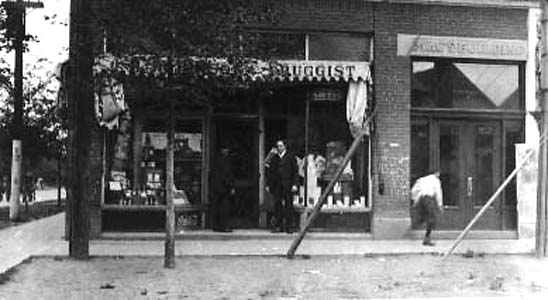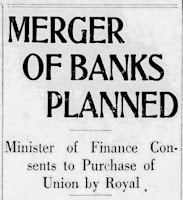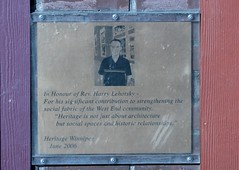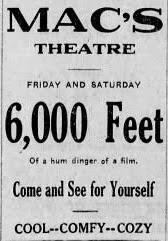© 2024, Christian Cassidy
Place: Mixed-use building
Address: 580 Ellice Avenue (Map)
Constructed: 1904 - 05
Builder: William B. Robinson

March 26, 1904, Winnipeg Free PressThis
was one of three residential dwellings on this block of Ellice Avenue to have building permits issued
in 1904. It was likely designed and built by carpenter William B. Robinson.
It was a time of great change for
this area of the city as the West End's pastureland was being laid out by surveyors into suburban lots with properly aligned
streets, boulevards, and sewer lines. Between 1905 and 1910, thousands
of houses and apartment blocks were built around this intersection.
This house's neighbour, the original St. Matthews Church (now the West End Cultural Centre), was already established on its site when the house was built but it was the original wooden structure. The brick building we see today came in 1909.
May 17, 1922, Winnipeg Tribune
Initially,
this served as a rooming house for some of the men
who built the West End.
The following are listed as renting a bed there in 1906: Robert Stone, boilermaker;
Herbert Mustow, bricklayer; Alexander Lawrence, plasterer; James Gray
teamster; and Joseph Beattie, steam fitter. The men were single, most in their twenties, and most immigrants from Britain.
It remained a rooming house for years to come. The 1911 census entry for 580 Ellice (see below) shows ten people living there: two couples, two children, and four lodgers. The above ad from 1922, when it already had live-in owners, advertised three residential suites for rent.

December 6, 1912, The Voice
May 1, 1913, Winnipeg Free Press
August 6, 1915, The Voice
Two of the people found in that 1911 census entry were travelling salesman Richard Holden and his wife Elizabeth. They were the first long-term resident-owners of the home and likely added the initial commercial extension to the front of the building that has been a feature for more than a century.
The first listing for a commercial enterprise comes in the 1912 street directory, which would have been compiled in 1911. It was Andrew Colville, jeweller and watchmaker, who lived at 692 Sherbrook Street and had his shop at 580 Ellice Avenue, (see ad below).
The following year, Richard
Holden decided to get off the road and replaced Colville's shop with his own sewing machine sales and repair shop. Newspaper ads show that he also dabbled in real estate from this address. After a couple of years, he added a small-run knitwear manufacturing business from the home.
The Holden residence was still packed with people despite having multiple businesses operating from it. The 1916 census entry (see below) shows Richard and Elizabeth Holden, the Thornton family with their two children, and one lodger.
This would be the Holdens' last year at 580 Ellice as world events would soon take them away.
Attestation papers for Richard Holden, Library and Archives Canada
Despite being in his late fifties, Holden enlisted for wartime service in May 1916.
It was fairly common practice when the "man of the house" enlisted that the spouse / family relocated to smaller premises or went to live with family due to the coming drop in household income. In this case, Richard and Elizabeth moved to Mansfield Court apartments at Ellice and Maryland.Holden was discharged from Camp Hughes in October 1916 for being "medically unfit for service". This could be because he lied about his age. Holden gave his age as 56 to the 1916 census taker but on his attestation papers he claimed his birth year was 1867 which made him 49.Undeterred, Holden reenlisted in December 1916 and noted "musician" as his trade rather than "sales agent". He also used what was likely his real birth year of 1859 which made him 57. He was accepted into the special services band unit of the 250th Battalion and spent some time in Calgary with the rank of Lance Corporal.Unfortunately, Holden was again discharged as unfit for service due to being "over age" in July 1917. The medical exam done prior to his dismissal noted that he was in "fair health", a "very corpulent man", (his measurements were 5 foot 4 inches in height with a 39 inch waist), with high blood pressure and and showing signs of hardening of the arteries.It is unclear what happened to the Holdens after the war. They seem to disappear from Winnipeg street directories and I cannot find obituaries for them. It could be that he and Elizabeth settled in Calgary together.

February 21, 1923, Winnipeg Free Press
The house was then owned by Samuel Maxwell, no occupation listed, for a couple of years. One of his lodgers, Mary Kirkup, ran her dressmaking shop from the retail space in 1917 and 1918.
Archibald McLellan, a carpenter, bought the house in 1920 and leased the retail space to Alfred F. Eacott, a shoemaker.
McLellan's era came to a close not long after a bloody dispute with a tenant named Alex Fennell in February 1923.
Fennell was having a drinking party in his upstairs suite with five or six guests. At 3 in the morning, McLellan decided to break up the party and demand the back rent that Fennell owed him. He took a carving knife along with him for protection.
A few minutes later, McLellan rushed back down the stairs "badly cut about the head and hands."
August 14, 1934, Winnipeg Tribune
From 1925 to 1936, Alex Johnston and his wife Margaret are the homeowners. The Johnstons were married in Lesmahagow, Scotland in 1902 and came to Winnipeg in 1910. They celebrated their silver anniversary at this house.
Mr. Johnston started out his time here as a meat cutter at Laurent Meat Market and within a few years was a butcher at HBC.
Late in the McLellan era or at the start of the Johnstons, it appears that the rooms for rent were converted into one larger suite as from this point forward street directories list additional people (usually just one person or a family) as "renters" rather than lodgers.
From 1928 to 1931, the renter was Catherine Tennant, a clerk at Kresge's and most likely a relative of Mrs. Johnston as Tennant was her maiden name.
Margaret died at the home in August 1934 at the age of 55 and the following year Mr. Johnston moved on.
Clarence
Ross, a carpenter, and his wife Clara were the homeowners from 1937 to
1949. They, too, continued to rent out the second residential suite.
August 12, 1938, Winnipeg Tribune
During the Johnston years and part way through the Ross years, the retail unit was a shoe repair shop under several proprietors: John Rollo (1925 to 1928), William Niznyk (1929 - 1933), Albert Leblanc (1934 - 1936), Harry Chabinyc (1937 - 1940), Emil Ruttig (1941), and Joseph Donato (1942 - 1943).
The retail unit then has no street directory listings from 1943 until the early 1950s. It is unclear if the structure was removed for a time or perhaps Mr. Ross, a carpenter, used it as a workshop or storage area.
Around 1950, John Arseniuk, a tailor, and his wife Mary (or Marie) bought the house. From 1953 to 1955, it was owned by Peter Selluski, an employee at Carter Motors, and his wife Madelaine.
It was under the Selluskis that a new retail tenant came on the scene. Audio Visual Supply Co., was a film distribution and motion picture equipment rental company owned by Marvin Melnyk. According to classified ads, the company marketed itself more towards residences or church basements that wanted to rent films and equipment rather than large cinemas.
September 17, 1966, Winnipeg Tribune
A major change came to 580 Ellice Avenue in 1954 in the form of its longest-term resident-owners who also ran their business from the retail space for 25 years.
The German Book Store was established in 1954 on Notre Dame Avenue by Eugen and Henriette Ambros who had come from Mannheim, Germany in 1952. As the name suggests, it specialized in German-language books and periodicals.
The store did not advertise in daily papers. The only mentions of it are in ads for the Winnipeg Film Society as one of ten or so ticket outlets for its showings of foreign and art films. The only newspaper mention of the business during that time is a June 1968 Free Press article noting that Ambros ran a German magazine rental service from the store that had customers all over North America.
The front retail extension of the house may have been rebuilt during the Ambros' ownership. A permit for a new retail extension was granted in 1967.
The Ambros' lived at the house and rented out the suite until 1958 then they lived there on their own until the store closed in 1980 and they moved out.
Eugen died in 1995 and is buried in Brookside Cemetery. No newspaper obituary can be found for him. Henriette's date of death, burial place, or obituary can't be found.
June 29, 1997, Winnipeg Free Press
From 1980 onward, there were a series of relatively shorter-term businesses that called the space home.
Asian Fashions, Arnjit & John Kooner and Marion Grewal, proprietors, was there from 1981 to 1984. It was Edlors Jewellery from 1986 to 1991under owner Eduardo Tumang who also lived in the residential portion.
After Edlors, a company called Seldor Enterprises tried opening a massage parlour in the building. Their 1992 application was rejected by the city after local residents protested. They did appeal and there was no follow-up news story about how that went. the license may have been granted as the building had no business listing for the next four years. (A massage parlour would not want itself listed in street directories for obvious reasons.)
Whether it was a massage parlour or sat empty, in 1997 it was advertised for sale as “fully equipped restaurant” with five rental units on the second floor for $114,900.
The building then took on a new life as a pizza joint. First it was Pepperoni Pete's from 1997 to 1998, then Niakwa Pizza in 1999, and Mr. Bones Pizza until 2003.
The pizza shop era ended in 2004 when Bear Clan Designs took it over in 2004 -2005.
King Cob Market Plus, the sign for which is still displayed on the side of the building, existed from around 2006 to 2007. In 2008, it became Katrina’s Bakeshop and Party Supply.
It then became a clothing store with Ji Xiang Clothing and Gifts in 2012 and Unicool Sports in 2016.
The retail portion of the building appears to have sat empty from 2018 onward.
The building was purchased in 2018 by Darryl Friesen, a 20-year resident of the West End, with plans to renovate it into a pub and eatery. He chose the name King Cob Market Pub due to the existing "King Cob Market Plus" sign on the side of the building and he liked the sound of it.
The pub was to have opened in 2022 but Friesen instead chose to extensively renovate the building from top to bottom. The main floor of the house is the commercial kitchen and the upstairs will continue to be a residence.
Some of the timber removed during the renovation of the house section of the building has been reused in the commercial section as wall panelling and the bar top.
King Cob Market Pub is expected to open in August 2024.
Related:
My Flickr album of 580 Ellice Avenue
First commercial tenant:
September 27, 1911, Winnipeg Free Press
Census entries for 580 Ellice:
1906 Census of Canada, Library and Archives Canada

1911 Census of Canada, Library and Archives Canada
1916 Census of the Prairie Provinces, Library and Archives Canada
























































